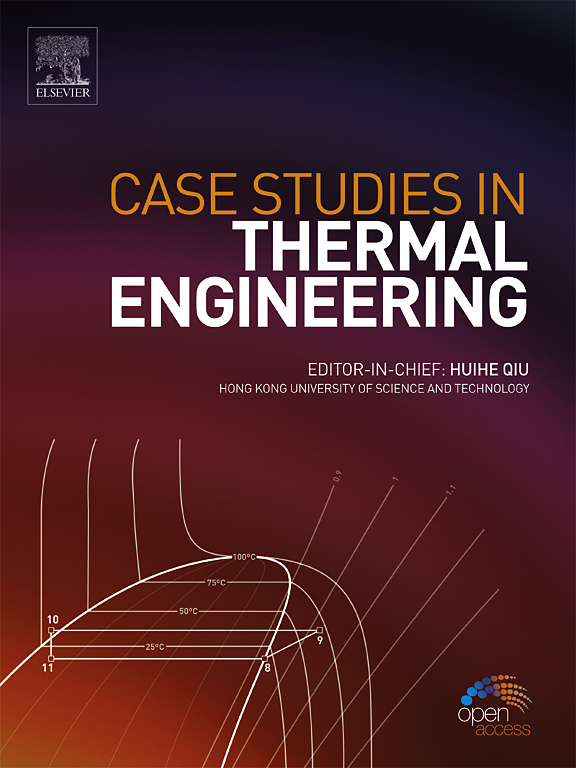NH4H2PO4细水雾对锂电池热失控可燃气体火焰的灭火性能及抑制机理研究
IF 6.4
2区 工程技术
Q1 THERMODYNAMICS
引用次数: 0
摘要
随着新能源汽车引发的火灾在道路交通事故中的比例不断上升,对锂电池火灾的扑灭研究变得尤为重要。电池热失控产生的火焰主要来源于热失控过程中释放的气体的燃烧。因此,有效抑制锂电池热失控火焰不仅需要降低电池温度,还需要有效抑制和扑灭热失控过程中逸出的可燃气体。鉴于磷酸铁锂电池热失控过程中释放的H2、CO等可燃气体占总产物的95%以上,本研究创新性地构建了以磷酸二氢铵(NH4H2PO4)水溶液为救火剂的小型火焰模拟系统,重点探索其灭火效率和反应动力学机理。本研究利用自建杯式燃烧器实验系统,考察了不同浓度梯度(1%、2%、5%和饱和状态)下雾剂的最小灭火浓度(MEC)。饱和溶液MEC为8.21%,明显优于氮气(11.04%)、二氧化碳(10.37%)和全氟己烷(9.34%)等传统灭火剂。在微观反应机理层面,利用Chemkin软件构建了包含1120个元素反应的综合动力学模型(Overall-Mech),确定了4个关键的抑制途径。研究表明,含磷活性物质通过形成HOPO↔PO2和HOPO2↔PO2的双重抑制循环,显著地消耗H/OH自由基浓度,降低总体反应速率。在宏观灭火实验中,饱和细水雾系统在3-5 s内实现了灭火,在随后的10 min恒温控制中,电池箱温度下降了89%,具有快速灭火和长时间热控保护的特点。本研究为解决新能源汽车锂电池热失控火灾问题提供了具有理论深度和实际应用价值的技术解决方案。本文章由计算机程序翻译,如有差异,请以英文原文为准。
Study on extinguishing performance and suppression mechanism of thermal runaway combustible gas flame of lithium battery by NH4H2PO4 water mist
As the proportion of fires caused by new energy vehicles in road traffic accidents continues to rise, research on the suppression of lithium battery fires has become particularly important. The flames resulting from thermal runaway of batteries primarily originate from the combustion of gases released during the thermal runaway process. Therefore, effectively suppressing the thermal runaway flames of lithium batteries not only requires reducing the battery temperature but also necessitates the effective suppression and extinguishment of combustive gases that escape during thermal runaway. Given that flammable gases such as H2 and CO released during the thermal runaway of lithium iron phosphate batteries account for more than 95 % of total products, this study innovatively constructs a small-scale flame simulation system using an ammonium dihydrogen phosphate (NH4H2PO4) aqueous solution as a firefighting agent, focusing on exploring its extinguishing efficiency and reaction kinetics mechanism.
Using a self-built cup burner experimental system, this study examines the minimum extinguishing concentration (MEC) of fogging agents at different concentration gradients (1 %, 2 %, 5 %, and saturation state). The saturated solution exhibits excellent performance with an MEC of 8.21 %, significantly outperforming traditional extinguishing agents such as nitrogen (11.04 %), carbon dioxide (10.37 %), and perfluorohexane (9.34 %). At the microscopic reaction mechanism level, a comprehensive kinetic model (Overall-Mech) containing 1120 elementary reactions was constructed using Chemkin software, identifying four key suppression pathways. The study reveals that phosphorus-containing active substances significantly deplete H/OH radical concentrations through the dual suppression cycle formation of HOPO↔PO2 and HOPO2↔PO2, reducing the overall reaction rate.
In the macro extinguishing experiments, the saturated fine water mist system realized fire extinguishment within 3–5 s, and the battery box temperature decreased by 89 % during the subsequent 10 min of constant temperature control, demonstrating both rapid extinguishing and prolonged thermal control protective characteristics. This research provides a technically valuable solution with both theoretical depth and practical applicability for addressing thermal runaway fires in lithium batteries of new energy vehicles.
求助全文
通过发布文献求助,成功后即可免费获取论文全文。
去求助
来源期刊

Case Studies in Thermal Engineering
Chemical Engineering-Fluid Flow and Transfer Processes
CiteScore
8.60
自引率
11.80%
发文量
812
审稿时长
76 days
期刊介绍:
Case Studies in Thermal Engineering provides a forum for the rapid publication of short, structured Case Studies in Thermal Engineering and related Short Communications. It provides an essential compendium of case studies for researchers and practitioners in the field of thermal engineering and others who are interested in aspects of thermal engineering cases that could affect other engineering processes. The journal not only publishes new and novel case studies, but also provides a forum for the publication of high quality descriptions of classic thermal engineering problems. The scope of the journal includes case studies of thermal engineering problems in components, devices and systems using existing experimental and numerical techniques in the areas of mechanical, aerospace, chemical, medical, thermal management for electronics, heat exchangers, regeneration, solar thermal energy, thermal storage, building energy conservation, and power generation. Case studies of thermal problems in other areas will also be considered.
 求助内容:
求助内容: 应助结果提醒方式:
应助结果提醒方式:


